By Adam Pagnucco.
Council Members Evan Glass and Will Jawando are two of the three top contenders to be the next county executive (along with their colleague Andrew Friedson). Both of them are in the county’s public campaign financing program. Both of them claim to be running grass roots campaigns. (Don’t all politicians make that claim?) And both have claimed to qualify for public matching funds in record time.
Well, it’s time to test that latter claim because their first campaign finance reports are in. Who is doing the better job of raising money? To the spreadsheets we go!
First, a bit of background. Public campaign financing is an optional program that candidates can select as an alternative to traditional financing. Under the county’s program, candidates in public financing may only collect contributions from individuals, with up to $12,000 in self-financing allowed along with other tiny adjustments (like refunds from vendors). Individual contributions are limited to $500 each. Public matching funds are available to supplement contributions from in-county residents, but there’s a catch: in order to qualify for those matching funds, candidates must hit thresholds of number of in-county contributors and amount received from them. For candidates running for executive, like Glass and Jawando, those thresholds are 500 in-county contributors donating at least $40,000. Hitting these thresholds is huge because matching funds dwarf these contributions and typically account for at least two-third of all receipts for publicly financed candidates.
One of the many things I like about public financing is that when participating candidates ask for matching funds, they have to send in full campaign finance reports to get them. For a spreadsheet-addicted fellow like myself, this is wonderful because I don’t have to wait for regular deadlines before I can see the money. And we do want to see the money, yeah? (For Friedson, who is using traditional financing, I have to wait until January to see his next report. But we all know that he will easily lead the fundraising in this race.)
Now to the reports. Jawando filed his report on August 20. It contains contributions received from May 5 through August 18. Glass filed his report on September 16. It contains contributions received from March 12 through September 15. So there is a comparability issue here that we need to bear in mind because Glass’s report covers a much longer time period than Jawando’s.
OK, let’s get started with a basic comparison: total funds raised during the periods.

Glass has an edge here. It’s reflected in the fact that he requested $375,540 in public matching funds while Jawando requested just $215,501. But remember: Glass’s report covers a much longer time period.
Let’s dig further. Here are individual contributions by month. (These exclude self-financing.)
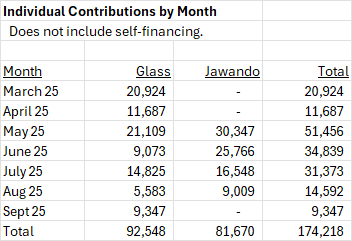
Glass raised more in total but Jawando raised more in each of the four common months they reported.
However, Jawando got significantly more money from outside the county than Glass. And that’s noteworthy because contributions from non-county residents are not eligible for matching funds. Here are contributions from in-county residents by month.
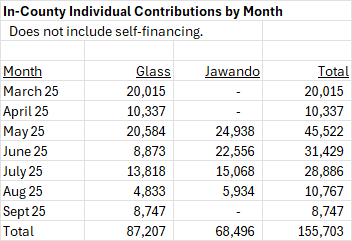
Jawando leads Glass again in their four common months but his edge is smaller.
What about the number of in-county contributors, one of the thresholds that candidates need to get matching funds? Here they are by month. I did not include multiple contributions from the same individual in making these calculations. (The combined spreadsheet had almost 2,000 lines in it so this took a while!)
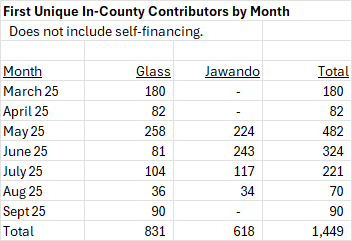
Glass jumped out to an early lead here. Jawando smoked him in June and the two were closely matched over the next two months.
Which one qualified faster? Well, technically it’s Jawando since he filed his report a month before Glass. (Why did you take so long to get your report in, Evan?) But the more interesting question is who reached eligibility faster from directly examining their receipts. And these are my calculations for the two of them.
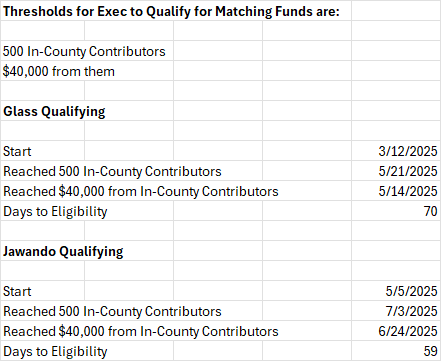
This was close, folks. Glass hit the thresholds in 70 days. Jawando hit them in 59 days. Jawando gets the bragging rights by a hair.
Here is an interesting table: average individual contributions by day, both total and for in-county contributors.
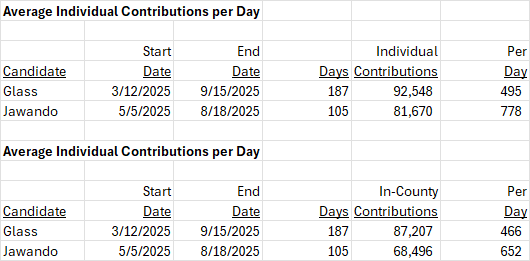
Jawando has a significant edge here but here is one reason why: his report covers a shorter time period. Contributions always spike right after a candidate declares, and they inevitably slow down, especially in the dog days of summer. Jawando’s report covers 105 days of fundraising. Here’s what happens if we compare his report to Glass’s first 105 days of fundraising.
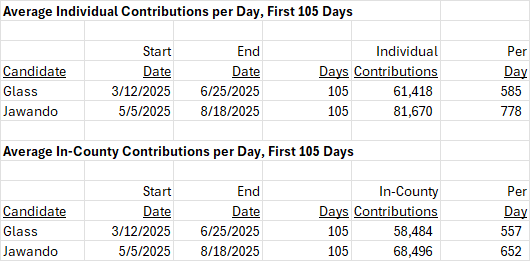
Jawando still has an edge but it’s smaller.
So what does all of this mean?
First of all, I think both Glass and Jawando are doing a great job. Glass is the best fundraiser as a council candidate ever in our public financing program (as I will show later in my public financing series) and Jawando did well in it when he used it in the 2018 cycle. I expect them both to collect the maximum in public matching funds (currently $870,170 for county executive candidates) and they should both have campaign budgets approaching $1.5 million. That’s more than enough for each of them to run the kind of campaign they want.
So far, Jawando may have an advantage over Glass in terms of intensity of support. We saw that in my series on bullet voting in the 2022 council at-large primary: more folks cast a ballot exclusively for Jawando than they did for Glass even though Glass led in total votes. Jawando is perceived as further to the left than Glass even though they’re both very progressive, and that’s reflected in brand loyalty by activists.
But in the end, fundraising won’t make the difference in this race. Friedson will have more money than Glass and Jawando combined and there are so many wild cards yet to be played. What we’re seeing here is early robust competition between two talented politicians which won’t matter much by election time.
Still, spreadsheets are fun and so is following money. When a few more reports come in, I’ll ask a more interesting question: what is the geographic distribution of their money? So come on, Glass and Jawando – send in some more data so we can read it all on Montgomery Perspective!
